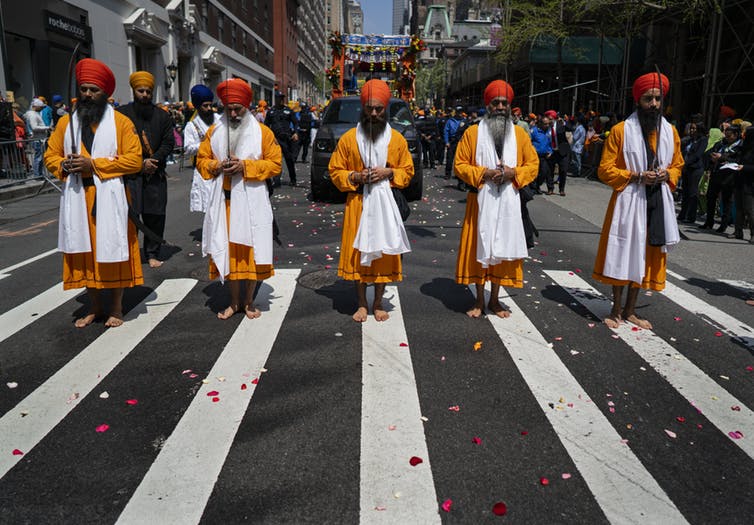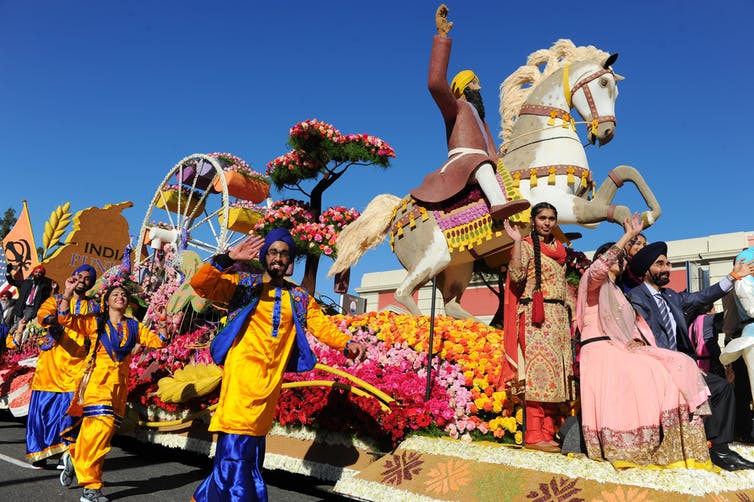Who Are the Sikhs and What Are Their Beliefs?
RELIGION, 13 Aug 2018
Simran Jeet Singh – The Conversation
9 Aug 2018 – New Jersey’s first Sikh attorney general, Gurbir Singh Grewal, was a target of disparaging remarks recently. Two radio hosts commented on Grewal’s Sikh identity and repeatedly referred to him as “turban man.” When called out on the offensiveness of their comments, one of them stated, “Listen, and if that offends you, then don’t wear the turban and maybe I’ll remember your name.”
Listeners, activists and Sikhs around the country acted immediately by contacting the station to express their concerns. News outlets quickly picked up the story and the radio hosts were suspended.
Grewal is a practicing Sikh who maintains a turban and beard. Scholars and government officials estimate the Sikh American population to number around 500,000. Nevertheless for many American Sikhs, such experiences are not uncommon. As a scholar of the tradition and a practicing Sikh myself, I have studied the harsh realities of what it means to be a Sikh in America today. I have also experienced racial slurs from a young age.
The bottom line is there is little understanding of who exactly the Sikhs are and what they believe. So here’s a primer.
Founder of Sikhism
To start at the beginning, the founder of the Sikh tradition, Guru Nanak was born in 1469 in the Punjab region of South Asia, which is currently split between Pakistan and the northwestern area of India. A majority of the global Sikh population still resides in Punjab on the Indian side of the border.
From a young age, Guru Nanak was disillusioned by the social inequities and religious hypocrisies he observed around him. He believed that a single divine force created the entire world and resided within it. In his belief, God was not separate from the world and watching from a distance, but fully present in every aspect of creation.
He therefore asserted that all people are equally divine and deserve to be treated as such.
To promote this vision of divine oneness and social equality, Guru Nanak created institutions and religious practices. He established community centers and places of worship, wrote his own scriptural compositions and institutionalized a system of leadership (gurus) that would carry forward his vision.
The Sikh view thus rejects all social distinctions that produce inequities, including gender, race, religion and caste, the predominant structure for social hierarchy in South Asia.

A community kitchen run by the Sikhs to provide free meals irrespective of caste, faith or religion, in the Golden Temple, in Punjab, India. shankar s., CC BY
Serving the world is a natural expression of the Sikh prayer and worship. Sikhs call this prayerful service “seva,” and it is a core part of their practice.
The Sikh identity
In the Sikh tradition, a truly religious person is one who cultivates the spiritual self while also serving the communities around them – or a saint-soldier. The saint-soldier ideal applies to women and men alike.
In this spirit, Sikh women and men maintain five articles of faith, popularly known as the five Ks. These are: kes (long, uncut hair), kara (steel bracelet), kanga (wooden comb), kirpan (small sword) and kachera (soldier-shorts).
Although little historical evidence exists to explain why these particular articles were chosen, the 5 Ks continue provide the community with a collective identity, binding together individuals on the basis of a shared belief and practice. As I understand, Sikhs cherish these articles of faith as gifts from their gurus.
Turbans are an important part of the Sikh identity. Both women and men may wear turbans. Like the articles of faith, Sikhs regard their turbans as gifts given by their beloved gurus, and its meaning is deeply personal. In South Asian culture, wearing a turban typically indicated one’s social status – kings and rulers once wore turbans. The Sikh gurus adopted the turban, in part, to remind Sikhs that all humans are sovereign, royal and ultimately equal.
Sikhs in America
Today, there are approximately 30 million Sikhs worldwide, making Sikhism the world’s fifth-largest major religion.
After British colonizers in India seized power of Punjab in 1849, where a majority of the Sikh community was based, Sikhs began migrating to various regions controlled by the British Empire, including Southeast Asia, East Africa and the United Kingdom itself. Based on what was available to them, Sikhs played various roles in these communities, including military service, agricultural work and railway construction.
The first Sikh community entered the United States via the West Coast during the 1890s. They began experiencing discrimination immediately upon their arrival. For instance, the first race riot targeting Sikhs took place in Bellingham, Washington, in 1907. Angry mobs of white men rounded up Sikh laborers, beat them up and forced them to leave town.
The discrimination continued over the years. For instance, when my father moved from Punjab to the United States in the 1970s, racial slurs like “Ayatollah” and “raghead” were hurled at him. It was a time when 52 American diplomats and citizens were taken captive in Iran and tension between the two countries was high. These slurs reflected the racist backlash against those who fitted the stereotypes of Iranians. Our family faced a similar racist backlash when the U.S. engaged in the Gulf War during the early 1990s.
The racist attacks spiked again after 9/11, particularly because Americans did not know about the Sikh religion and conflated the unique Sikh appearance with popular stereotypes of what terrorists look like.
In comparison to the past decade, the rates of violence against Sikhs have surged since the election of President Donald Trump. The Sikh Coalition, the largest Sikh civil rights organization in the U.S., estimated earlier this year that Americans Sikhs were being targeted in hate crimes about once a week. Just in the past two weeks, two Sikh men have been brutally assaulted in California. Police are still investigating the motivation.
As a practicing Sikh, I can affirm that the Sikh commitment to the tenets of their faith, including love, service and justice, keeps them resilient in the face of hate. For this reason, for many Sikh Americans, like Gurbir Grewal, it is rewarding to maintain their unique Sikh identity.
_________________________________________
 Simran Jeet Singh – Henry R. Luce Post-Doctoral Fellow in Religion in International Affairs Post-Doctoral Fellow, New York University
Simran Jeet Singh – Henry R. Luce Post-Doctoral Fellow in Religion in International Affairs Post-Doctoral Fellow, New York University
Republish The Conversation articles for free, online or in print, under Creative Commons license.
Go to Original – theconversation.com
DISCLAIMER: The statements, views and opinions expressed in pieces republished here are solely those of the authors and do not necessarily represent those of TMS. In accordance with title 17 U.S.C. section 107, this material is distributed without profit to those who have expressed a prior interest in receiving the included information for research and educational purposes. TMS has no affiliation whatsoever with the originator of this article nor is TMS endorsed or sponsored by the originator. “GO TO ORIGINAL” links are provided as a convenience to our readers and allow for verification of authenticity. However, as originating pages are often updated by their originating host sites, the versions posted may not match the versions our readers view when clicking the “GO TO ORIGINAL” links. This site contains copyrighted material the use of which has not always been specifically authorized by the copyright owner. We are making such material available in our efforts to advance understanding of environmental, political, human rights, economic, democracy, scientific, and social justice issues, etc. We believe this constitutes a ‘fair use’ of any such copyrighted material as provided for in section 107 of the US Copyright Law. In accordance with Title 17 U.S.C. Section 107, the material on this site is distributed without profit to those who have expressed a prior interest in receiving the included information for research and educational purposes. For more information go to: http://www.law.cornell.edu/uscode/17/107.shtml. If you wish to use copyrighted material from this site for purposes of your own that go beyond ‘fair use’, you must obtain permission from the copyright owner.


